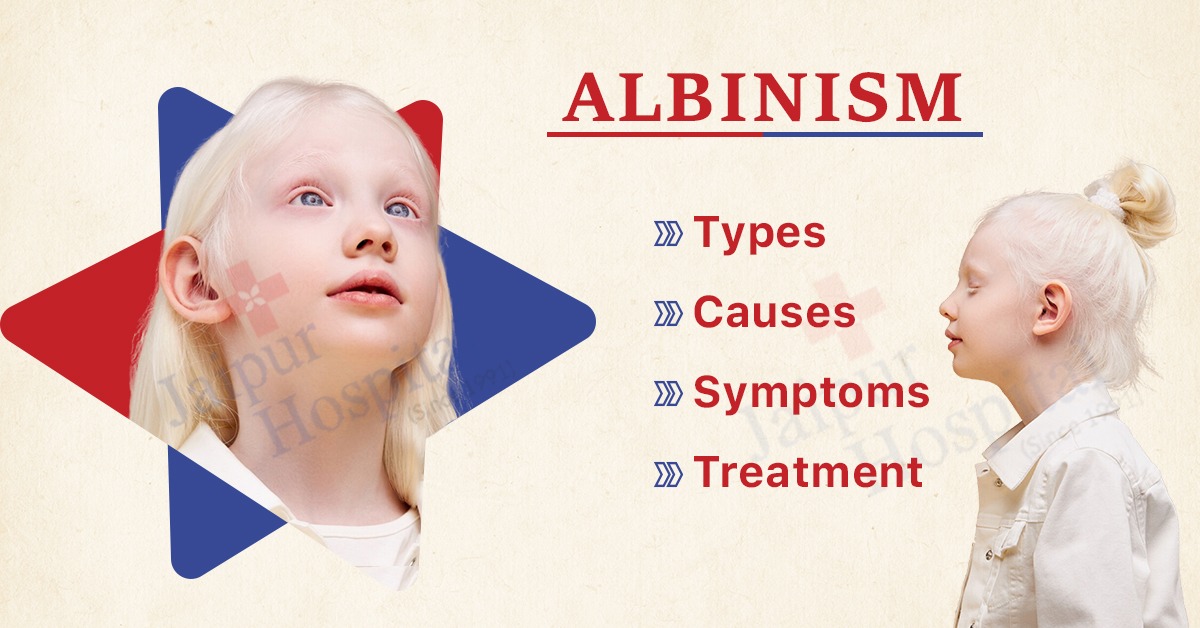What is Albinism?
Albinism is a genetic condition characterized by a lack of melanin production in the body, resulting in a range of clinical manifestations such as pale skin, light-colored hair, and often, vision problems. This congenital disorder can affect individuals of all ethnicities and is caused by various genetic mutations affecting melanin production. In this exploration, we will delve into the genetic basis of albinism, its clinical features and classifications, the social implications and challenges faced by individuals with albinism, and the advancements in medical and technological interventions aimed at improving their quality of life. Additionally, we will discuss the cultural perceptions and misconceptions surrounding albinism, highlighting the importance of awareness and acceptance within society.
Types of Albinism:
Albinism is a genetic condition characterized by a lack of melanin pigment in the hair, skin, and eyes, resulting in lighter-colored hair, skin, and eyes, as well as vision problems. There are several types of albinism, including:
- Oculocutaneous Albinism (OCA):
- OCA1: This type is caused by a mutation in the TYR gene, resulting in little to no melanin production in the skin, hair, and eyes.
- OCA2: It is caused by a mutation in the OCA2 gene, which affects melanin production primarily in the eyes and hair.
- OCA3 (also known as Rufous OCA or Rufous-albinism): This type is caused by mutations in the TYRP1 gene and typically occurs in people of African descent. It results in reddish-brown hair and more pigmented skin compared to other types of albinism.
- OCA4: This type is caused by mutations in the SLC45A2 gene, affecting melanin production in the skin, hair, and eyes.
- Ocular Albinism (OA):
- OA1: Also known as Nettleship-Falls syndrome, it primarily affects the eyes, causing vision problems such as nystagmus (involuntary eye movements), reduced visual acuity, and strabismus (crossed eyes). It is caused by mutations in the GPR143 gene.
- OA2: This type is less common and is caused by mutations in the CACNA1F gene. It also primarily affects the eyes.
- Hermansky-Pudlak Syndrome (HPS):
- This is a rare form of albinism characterized by a lack of melanin in the skin, hair, and eyes, as well as a bleeding disorder and other health issues. There are several subtypes of HPS, each caused by mutations in different genes involved in the formation and function of specialized cell structures called melanosomes, which produce and store melanin.
Also read: Psoriasis: Symptoms, Causes, Types, Risk Factors, Diagnosis & Treatment
Causes of Albinism:
Albinism is primarily caused by genetic mutations that affect the production or distribution of melanin, the pigment responsible for the color of the skin, hair, and eyes. There are several known genetic causes of albinism, which can vary depending on the type:
- Oculocutaneous Albinism (OCA):
- OCA1: Caused by mutations in the TYR gene, which provides instructions for producing the enzyme tyrosinase. Tyrosinase is essential for melanin synthesis.
- OCA2: Caused by mutations in the OCA2 gene, which codes for a protein involved in the transport of tyrosinase within melanocytes, the cells responsible for producing melanin.
- OCA3: Caused by mutations in the TYRP1 gene, which provides instructions for producing a protein involved in melanin synthesis.
- OCA4: Caused by mutations in the SLC45A2 gene, which codes for a protein involved in melanin transport.
- Ocular Albinism (OA):
- OA1: Caused by mutations in the GPR143 gene, which provides instructions for producing a protein involved in the development and function of melanocytes in the eye.
- OA2: Caused by mutations in the CACNA1F gene, which codes for a protein that plays a role in the function of retinal cells involved in vision.
- Hermansky-Pudlak Syndrome (HPS):
- HPS is caused by mutations in various genes involved in the formation and function of melanosomes, specialized cell structures that produce and store melanin. The most common genes associated with HPS include HPS1, HPS3, HPS4, HPS5, HPS6, DTNBP1, and AP3B1.
Symptoms of Albinism:
Albinism manifests with various symptoms, primarily due to the lack of melanin pigment in the body. The symptoms can vary in severity among individuals and depend on the type of albinism they have. Here are some common symptoms associated with albinism:
- Skin:
- Very light skin tone: Individuals with albinism typically have lighter skin compared to others in their family or ethnic group.
- Increased susceptibility to sunburn: The lack of melanin in the skin makes individuals with albinism more vulnerable to sunburn and skin damage from UV radiation.
- Freckles and moles: Some individuals with albinism may develop freckles and moles due to increased sun sensitivity.
- Hair:
- Light-colored hair: Hair color ranges from white to light yellow, blond, or light brown, depending on the type of albinism.
- Sparse eyebrows and eyelashes: Many individuals with albinism have sparse or very light-colored eyebrows and eyelashes.
- Eyes:
- Hypopigmented iris: The iris, which is normally pigmented, appears translucent or very light blue, gray, or pinkish in individuals with albinism.
- Nystagmus: Involuntary rapid eye movements, which can affect vision clarity.
- Strabismus: Misalignment of the eyes (crossed eyes) may occur in some individuals.
- Reduced visual acuity: Many people with albinism experience reduced sharpness of vision (visual acuity), which can range from mild to severe.
- Photophobia: Increased sensitivity to light, which can cause discomfort and difficulty in bright environments.
- Foveal hypoplasia: Underdevelopment of the area of the retina responsible for sharp central vision (fovea), leading to reduced visual acuity.
- Vision:
- Vision problems: Albinism often causes various vision impairments, including nearsightedness, farsightedness, astigmatism, and depth perception issues.
- Decreased visual field: Some individuals with albinism may have a reduced field of vision, affecting their ability to see objects in their peripheral vision.
Diagnosis of Albinism:
Diagnosing albinism typically involves a combination of clinical evaluation, physical examination, and genetic testing. Here’s an overview of the diagnostic process:
- Clinical Evaluation:
- A doctor or healthcare provider will perform a thorough medical history assessment, including questions about a family history of albinism or related eye conditions.
- A physical examination will be conducted to assess the individual’s skin, hair, and eye characteristics, which may include:
- Skin tone: Individuals with albinism typically have very light skin.
- Hair color: Hair color ranges from white to light yellow, blond, or light brown.
- Eye color: The iris may appear translucent or very light blue, gray, or pinkish.
- Eye movements: Nystagmus (involuntary eye movements) and strabismus (misalignment of the eyes) may be observed.
- Visual acuity: Testing visual acuity (sharpness of vision) using eye charts.
- Other eye abnormalities: Assessing for foveal hypoplasia (underdevelopment of the area of the retina responsible for sharp central vision) and photophobia (increased sensitivity to light).
- Eye Examination:
- An ophthalmologist, a medical doctor specializing in eye care, will conduct a comprehensive eye examination to assess visual function and identify any eye abnormalities associated with albinism. This may include:
- Measurement of visual acuity using standardized eye charts.
- Evaluation of eye movements, alignment, and tracking.
- Examination of the retina, optic nerve, and other structures at the back of the eye.
- Assessment of light sensitivity and glare.
- Testing for refractive errors such as nearsightedness, farsightedness, and astigmatism.
- Genetic Testing:
- Genetic testing may be recommended to confirm the diagnosis of albinism and identify the specific genetic mutation responsible for the condition.
- Genetic testing can involve analyzing DNA samples obtained from blood or saliva to identify mutations in genes associated with albinism, such as TYR, OCA2, TYRP1, GPR143, and others.
- Identifying the underlying genetic cause of albinism can help provide information about the type and severity of the condition, as well as guide treatment and management decisions.
- An ophthalmologist, a medical doctor specializing in eye care, will conduct a comprehensive eye examination to assess visual function and identify any eye abnormalities associated with albinism. This may include:
Treatment of Albinism:
Albinism itself does not have a cure, as it is a genetic condition characterized by a lack of melanin pigment production. However, management and treatment strategies focus on addressing associated symptoms and complications, as well as maximizing visual function and overall well-being. Here are some key aspects of the treatment and management of albinism:
- Sun Protection:
- Sun protection is crucial for individuals with albinism due to their increased sensitivity to sunlight and susceptibility to sunburn and skin damage.
- Strategies for sun protection may include:
- Wear protective clothing, such as wide-brimmed hats, long-sleeved shirts, and pants.
- Use a broad-spectrum sunscreen with a high sun protection factor (SPF) regularly and reapply it as needed, especially when outdoors.
- Seeking shade and avoiding prolonged sun exposure, particularly during peak sunlight hours.
- Using sunglasses with UV protection to shield the eyes from harmful UV radiation.
- Vision Correction:
- Many individuals with albinism experience vision problems such as nearsightedness, farsightedness, astigmatism, and reduced visual acuity.
- Vision correction may involve prescription eyeglasses or contact lenses to improve visual clarity and focus.
- Some individuals may benefit from low-vision aids, such as magnifiers, telescopes, or electronic devices, to enhance reading and other visual tasks.
- Ophthalmic Care:
- Regular eye examinations by an ophthalmologist are essential for monitoring eye health and identifying any complications associated with albinism, such as refractive errors, strabismus, and nystagmus.
- Treatment for specific eye conditions may include corrective lenses, eye muscle surgery for strabismus, and other interventions as needed to optimize visual function.
- Education and Support:
- Education and support services can help individuals with albinism and their families better understand the condition, manage associated challenges, and access resources and support networks.
- Genetic counseling may be beneficial for individuals and families to understand the genetic basis of albinism, inheritance patterns, and family planning options.
- Psychological and Social Support:
- Living with albinism may present various psychosocial challenges, including coping with visual impairment, managing self-esteem, and addressing social stigma.
- Counseling and support groups can provide emotional support, guidance, and a sense of community for individuals with albinism and their families.
Complications of Albinism:
Individuals with albinism may experience various complications related to the lack of melanin pigment and associated vision problems. Some common complications include:
- Vision Problems: Albinism often leads to a range of vision impairments, including:
- Reduced Visual Acuity: Many individuals with albinism have decreased sharpness of vision, which can impact their ability to see fine details and objects.
- Nystagmus: Involuntary, rapid eye movements that can impair visual acuity and make it difficult to maintain steady vision.
- Strabismus: Misalignment of the eyes, which can cause double vision and affect depth perception.
- Refractive Errors: Common refractive errors such as nearsightedness (myopia), farsightedness (hyperopia), and astigmatism are more prevalent among individuals with albinism.
- Photosensitivity: People with albinism are highly sensitive to sunlight due to the lack of protective melanin pigment in the skin and eyes. This can lead to sunburn, increased risk of skin cancer, and eye damage from UV radiation exposure.
- Skin Cancer: The absence of melanin in the skin increases susceptibility to sunburn and raises the risk of developing skin cancers, including basal cell carcinoma, squamous cell carcinoma, and melanoma.
- Psychosocial Challenges: Living with albinism may lead to psychosocial difficulties, including:
- Self-Esteem Issues: Concerns about appearance, social acceptance, and discrimination may affect self-esteem and confidence.
- Social Stigma: Misconceptions, stereotypes, and discrimination based on appearance may lead to social isolation and negative experiences.
- Educational Challenges: Vision impairments associated with albinism can pose challenges in educational settings, including reading difficulties, difficulty seeing classroom materials, and challenges with visual tasks.
- Ocular Complications: Albinism can be associated with various eye abnormalities and conditions, such as:
- Amblyopia: Reduced vision in one or both eyes due to abnormal visual development during childhood.
- Optic Nerve Hypoplasia: Underdevelopment of the optic nerve, which can impair vision.
- Foveal Hypoplasia: Underdevelopment of the central area of the retina (fovea), resulting in reduced central visual acuity.
- Emotional and Mental Health Concerns: Coping with the challenges of albinism, including vision impairment, social stigma, and discrimination, can impact emotional well-being and mental health, leading to anxiety, depression, and stress.


